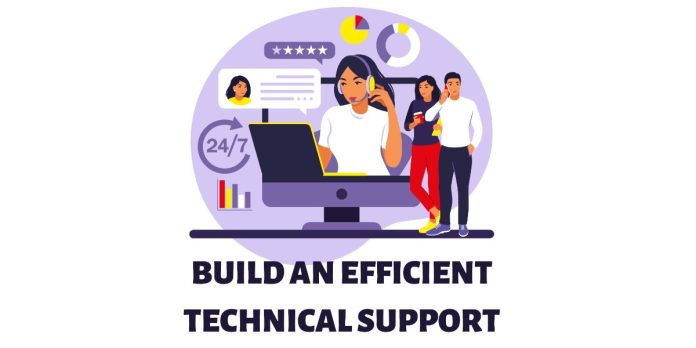Technical support representatives are often the unsung heroes of many companies. They have the important job of resolving technical issues, such as troubleshooting software glitches and providing guidance for using hardware.
They do all this while engaging, calming and satisfying customers, which can be challenging. A technical support representative’s job also allows them to contribute crucial insights from customers that can help you improve your products and services. In essence, technical support teams facilitate glitch-free operations while cultivating customer loyalty, cementing your company’s reputation for reliability and care in today’s tech-driven world.
With the important job technical support representatives have, finding the right talent to fill these roles is essential.
You have the option to hire an in-house team or outsource your technical support representatives to the Philippines and other affordable countries to ensure you have the staff you need to handle this role.
When you outsource your technical support team, you can work with experienced and skilled talent who can handle all the tasks you give them without extensive training.
This business solution also allows you to save money on training, office equipment and other essentials you need to employ technical support representatives. Additionally, you have the opportunity to have a team that works round-the-clock since you can hire staff from different countries and time zones.
Essential Tools for Technical Support Teams
Whether you hire an in-house team or outsource your technical support representatives, you need to ensure they have access to the right tools to do their job properly.
Below are the eight essential tools your technical support team needs to perform their duties and be a valuable asset to your company:
- Ticketing system.
This tool is crucial for streamlining customer queries and your team’s workflow.
Ticketing systems, such as Help Scout, Zendesk and Zoho, allow customers to submit their issues, inquiries, or requests, which are then organized into tickets.
Each ticket is then assigned a unique identification and number, making it easier for your technical support representatives to track, prioritize, and resolve customer concerns systematically.
- Customer relationship management (CRM) software.
A CRM system enables your technical support team to manage customer interactions seamlessly.
CRM tools, such as Salesforce, Zoho and Pipedrive, store vital customer information, purchase history, previous issues and preferences in one centralized platform.
These platforms enable your team to provide personalized support, anticipate needs, and enhance the overall customer experience.
Some ticketing systems, such as Zendesk and Zoho, also work as CRM tools. Study these options well if you want to get software that functions as both.
- Live chat software.
If you want your technical support team to provide real-time assistance to your customers, you need to invest in live chat software.
Live chat software, such as Intercom, Pure Chat and Live Agent, facilitates instant communication between customers and support agents. It caters to people seeking quick solutions to their problems.
Unlike traditional phone calls and emails, live chat happens in real time. This allows your team to assist your customers immediately, leading to improved efficiency and reduced response times.
- Call center software.
Since many customers still prefer traditional phone or voice support, you may want to look into providing this option. This means using call center software.
Artificial intelligence for call centers enables to handle incoming and outgoing calls efficiently. These tools have features like call routing, recording and analytics that can help your agents manage calls better and improve customer satisfaction.
Examples of widely used call center software include Talkdesk, Freshdesk and Avaya.
- Communication tools.
Efficient internal communication is crucial for a successful technical support team.
Tools like Slack, Skype and Microsoft Teams facilitate real-time collaboration among team members.
These tools allow your agents to share insights, ask for assistance and update each other on ongoing cases to ensure a cohesive support approach.
- Analytics and reporting tools.
To continuously enhance your support team’s performance, you need to have the right analytics and reporting tools.
These tools, which include Zoho Pagesense and Zendesk Explore, give you insights into various key metrics, such as response times, ticket resolution rates and customer satisfaction scores.
With these data-driven insights, you can identify areas for improvement and change or modify your team strategies.
- Screen recording software.
Some customers may have difficulties following or understanding verbal or written instructions for troubleshooting complex technical solutions effectively.
Screen recording software, like OBS Studio, Snagit and ShareX, allows your team to record their screens and show step-by-step instructions the customer needs to follow.
Your agents can share these recordings with the customers, giving them clearer and concise guidance that they can understand easily.
- Remote desktop software.
This tool enables your technical support agents to access customers’ computers or devices from a distance.
TeamViewer, AnyDesk, Chrome Remote Desktop and other remote desktop software allow you and your team to connect to and access a computer remotely.
Once connected, you can access files and perform functions on your desktop like you are using the remote computer directly.
With this tool, your agents can troubleshoot problems as if they were with the customer physically, saving time and giving them a smooth experience.
Investing in all these tools can cost a fortune. When you outsource your technical support team, you and your agents can access and use these types of software with no additional costs.
With outsourcing solutions, you can build your technical support representatives and support their success from the start.
